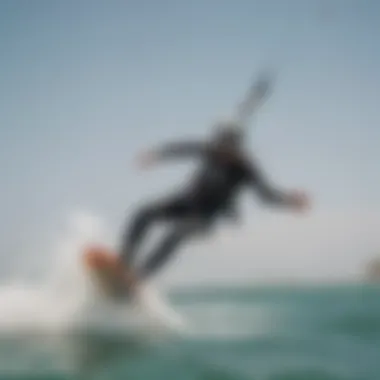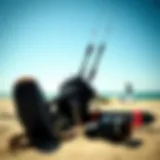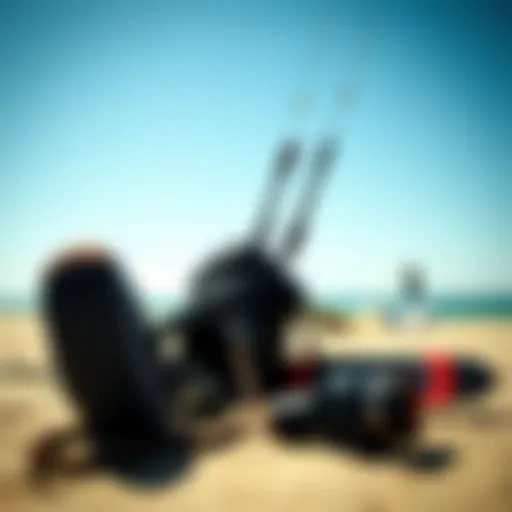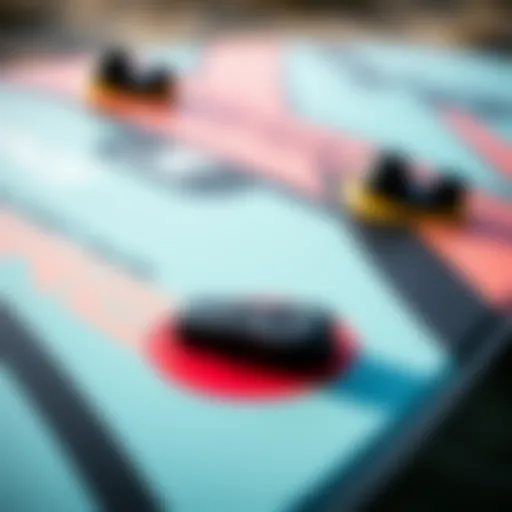The Impact of Sliding Stoppers on Kiteboarding


Intro
Kiteboarding is a sport that brims with excitement and nuance. Whether you’re a weekend warrior or a seasoned pro, understanding the equipment and techniques can turn a good ride into an extraordinary experience. One key piece of gear, often overshadowed by boards and kites, is the sliding stopper. This inconspicuous element plays a pivotal role in managing your performance on the water.
This article takes you on a journey to unveil the ins and outs of the sliding stopper, dissecting its mechanics, benefits, and applications. You’ll come to appreciate its role not just in elevating your maneuvers but also in bolstering your safety while kiteboarding. So fasten your seatbelt—or should we say your harness—and journey into the depths of kiteboarding technology that makes riding the waves both thrilling and secure.
Foreword to Sliding Stoppers
In the world of kiteboarding, the importance of the sliding stopper cannot be overstated. This essential component plays a pivotal role in enhancing the rider's experience, providing crucial control during maneuvers, and ensuring safety in a sport where conditions can change in the blink of an eye. Understanding what the sliding stopper is and its functionalities is fundamental for both novices and seasoned practitioners alike.
Definition and Purpose
A sliding stopper is a device positioned on the lines connecting the kite to the harness. It serves as a stop for the line, allowing the rider to adjust the position of the kite with ease while maintaining control. When the rider pulls on the bar, the stopper moves along the line, permitting the kite to rise or dip depending on the desired maneuver. This movement can make a significant difference in how a kite performs in various wind conditions.
The primary purpose of the sliding stopper lies in enhancing user control and safety. When utilized correctly, it enables quick adjustments to the kite's position, making the ride more responsive. Without this device, a kiteboarder may find themselves in a precarious situation, struggling to control their kite under strong winds or during jumping stunts. Thus, incorporating a sliding stopper into one’s setup is much more than a minor adjustment; it’s about elevating the entire kiteboarding experience.
Historical Context
The evolution of kiteboarding has witnessed significant technological advancements. Early kiteboards often lacked sophisticated control devices. Kiteboarders predominantly relied on their skill and intuition to navigate the waters. The initial designs utilized fixed stoppers, which were rather limiting and did not allow for dynamic adjustment in response to changing conditions.
Over time, with the growing popularity of the sport, the need for better control systems became evident. This led to the development of sliding stoppers. As kiteboarding gained traction in the early 2000s, innovations took shape, drawing inspiration from other water sports and aiming to meet the needs of a more demanding audience. The introduction of this adjustable component transformed the way kiteboarders interacted with their kites, promoting safer and more thrilling experiences.
In summary, the sliding stopper has become a crucial element in modern kiteboarding, blending both safety and performance in a way that aligns with the evolving nature of the sport. Understanding its definition, purpose, and historical relevance sets the stage for a deeper exploration of its mechanics and applications in the following sections.
Mechanics of the Sliding Stopper
The mechanics of the sliding stopper are central to understanding how kiteboarders maintain control and manage safety while riding. This section dives into the essential elements that make up a sliding stopper, how they function during various kiteboarding maneuvers, and the materials that influence their performance. Grasping these concepts not only enhances a kiteboarder's knowledge but also directly affects the experience they have on the water.
Basic Components
At the heart of the sliding stopper's function are several key components. These elements work in harmony to provide both flexibility and security while ensuring the rider can react to the changing conditions of the water and wind.
- Stopper Ball: This is the primary element that moves along the line of the harness. It can glide freely or lock in place, depending on the rider’s needs.
- Line: Typically made from a robust and durable material, the line connects the harness to the bar. It's designed to bear the tension and is essential for the stopper's function.
- Attachment Points: These are the specific placements on the harness where the sliding stopper is secured. They facilitate easy adjustments during riding.
- Adjustment Mechanism: A system that allows the rider to modify the positioning of the stopper ball based on they style of riding, whether cruising or freestyle.
These components are fundamental to the overall functionality of sliding stoppers, allowing for a smoother ride and better responsiveness during action.
Operation Principles
Understanding how sliding stoppers operate is crucial for kiteboarders wishing to maximize their enjoyment on the water. When the rider pulls on the bar, the stopper ball moves up the line toward the harness. This action serves a few significant purposes:
- Control: By sliding into place, the stopper provides additional tension that helps maintain control while performing tricks or navigating choppy waters.
- Safety: In case of a fall or sudden shift, the stopper can lock into place, preventing the rider from unintentionally disconnecting from their lines.
- Adjustment: Adapting the position based on personal preference or wind conditions allows for versatility in riding style.
It's a blend of mechanics and instinct, where each kiteboarder learns to gauge exactly when to shift the position of the stopper for optimal performance.
Material Considerations
The materials used in the construction of sliding stoppers impact their overall durability and performance. Kiteboarders need to be aware of these factors:
- Nylon: Often used for the stopper ball due to its strength and resistance to abrasion.
- Polyester: Commonly utilized in the line for its low stretch and high tensile strength, ensuring durability through various riding conditions.
- Composites: In some higher-end models, advanced materials may be used to reduce weight while enhancing strength and functionality.
When selecting a sliding stopper, one must not only consider build quality but also how these materials will withstand the impacts of saltwater, sun exposure, and general wear and tear over time.
"Choosing the right materials for your sliding stopper can make a world of difference in performance and longevity."
Incorporating the appropriate materials leads to a balanced approach in usage and maintenance, ensuring that kiteboarders can focus on their rides without constantly worrying about equipment failure.
Types of Sliding Stoppers
When it comes to kiteboarding, having the right gear can mean the difference between a stellar day on the water and an experience marred by frustration. One often-overlooked component that plays a crucial role in your performance is the sliding stopper. This section delves into the types of sliding stoppers available, elucidating their implications for kiteboarders of all skill levels.
Fixed vs. Adjustable Stoppers
Fixed stoppers are the quintessential, no-nonsense choice. They provide a solid anchor point that doesn’t budge once you set it. A common concern among kiteboarders is whether or not they can easily adjust their equipment in the heat of the moment. With fixed stoppers, you’re trading off flexibility for reliability. This might appeal to some riders who feel confident in their current setup and would rather not mess with adjustments during their session.
On the other hand, adjustable stoppers are taking the crown when it comes to versatility. They allow users to change the positioning while out on the water, giving kiteboarders the ability to respond to various conditions. For example, during a windy day with high waves, an adjustable stopper lets you steer your kite more effectively as you shift your weight or stance.
Here’s a quick breakdown of each type:
- Fixed Stoppers:
- Adjustable Stoppers:
- Consistent performance.
- Limited adaptability.
- Flexibility in positioning.


- Potential for malfunctions if not secured properly.
Ultimately, the choice between fixed and adjustable stoppers boils down to personal preference and riding style. If you lean more towards freestyle kiteboarding, having that adjustability might be a game-changer for tricks and maneuvers. However, if you prefer steady cruising on calmer waters, the stability of fixed stoppers may fit the bill better.
Integration with Harness Systems
Understanding how sliding stoppers mesh with your harness system is vital for optimizing performance. Many riders don’t realize the importance of this integration until they’re bouncing along the waves and struggling to maintain balance due to a subpar setup.
Most harness systems allow for seamless integration of sliding stoppers, ensuring that they work in harmony. Your choice of harness—be it waist or seat—can influence how the sliding stopper performs. For instance, in a waist harness, combining an adjustable sliding stopper can lead to better control, especially when performing jumps or spins.
When looking at the right combination, here are some points to consider:
- Control and Comfort:
Each harness comes with its own specifications. Make sure your sliding stopper complements those. - Materials Compatibility:
Some sliding stoppers made from heavier materials might not mesh well with lightweight harnesses, leading to performance issues. - Adjustment Mechanisms:
Some harness systems have integrated mechanisms for adjusting stoppers. Familiarizing yourself with these can ease on-water adjustments.
"Choosing the right sliding stopper isn't just about preference; it’s about enhancing your whole kiteboarding experience."
Benefits of Using a Sliding Stopper
When it comes to kiteboarding, the nuances in gear can make all the difference between a great ride and a precarious tumble. One of the standout components aiding in this dynamic is the sliding stopper. This piece of equipment isn't just an afterthought; rather, its benefits are profound and multifaceted, influencing control, safety, and overall performance.
Enhanced Control
At the heart of kiteboarding lies the need for control over both the kite and the board. The sliding stopper enhances this control in several significant ways. Firstly, it allows riders to easily adjust the position of the trim line while in motion. This is crucial during varied wind conditions — whether you’re battling strong gusts or cruising in lighter winds, having that flexibility can spell the difference between staying on course and spiraling out of control.
Additionally, the ability to shift the stopper alters the angle at which the kite operates, letting users fine-tune their ride. Imagine gliding through waves, and when a sudden gust comes, you can easily adjust your stance by pulling on the stopper, gaining that much-needed heft to avoid being lifted off the water. This real-time adaptability is essential for achieving a smooth ride and elevating one’s skill set. The straightforward mechanics of sliding stoppers offer kiteboarders the confidence to push their limits on the water.
Safety Features
When it comes to kiteboarding, safety is paramount. The sliding stopper plays a crucial role in enhancing safety measures, primarily through its capacity to release tension in the lines during unexpected falls or mishaps. If you’ve ever been caught in a tricky situation, you might have found yourself frantically trying to regain balance while fretting over the kite's potential movement.
"A slipping kite can lead to icy waters or twisted lines. The sliding stopper allows a quick way to manage this."
Another significant safety aspect is how these stoppers can prevent line tangles. If your lines get tangled, it could result in an uncontrolled descent or even worse. A well-placed sliding stopper minimizes the chances of entanglements when the kite goes down, thus protecting the integrity of the entire system.
Improved Performance
In the world of kiteboarding, performance is everything. The sliding stopper enhances performance by allowing for more dynamic movements that can be crucial in competitive settings. For freestyle riders, this means executing tricks with increased precision. Having the ability to adjust the trim easily means a rider can make split-second decisions to optimize their performance during a trick or maneuver.
Moreover, the sliding stopper can affect speed and response time. When paired with different types of lines, it can create a symphony of responsiveness that is both swift and reliable. This amplification of performance can be beneficial for both amateurs trying to hone their skills and seasoned pros aiming for the podium.
In terms of material and design advancements, newer sliding stoppers even come equipped with features that further enhance their functionality, proving that these components are not merely utilitarian but also critical for peak performance.
In summary, the benefits of using a sliding stopper in kiteboarding are manifold, covering essential aspects of control, safety, and performance, which all tie into the richer experience of being out on the water.
Choosing the Right Sliding Stopper
Selecting the right sliding stopper for your kiteboarding adventures is like choosing the perfect blade for a sword; it can make all the difference in how you perform on the water. Each kiteboarding style and personal preference require different setups, making this decision both critical and often overwhelming for newcomers and even seasoned riders. Let’s break down some aspects you should consider when navigating this crucial choice.
Assessing Personal Needs
Before diving headfirst into the world of sliding stoppers, it’s vital to assess what your personal needs are. This will depend largely on your skill level, riding style, and typical conditions you face.
- Skill Level: Are you a beginner still finding your rhythm, or are you experienced and trying to push your limits?
- Riding Style: If you're more into freestyle kiteboarding, you might be looking for a stopper that allows for maximum maneuverability. On the other hand, wave riders may want something that provides stable control even in choppy waters.
- Conditions: Different environments, such as flat water, waves, or high winds, may influence your decision. You might need a more robust, reliable design for extreme conditions.
Gathering all this information can help narrow down your options significantly and ensure you’re not just picking the latest flashy design, but one that best suits your specific riding scenario.
Compatibility with Equipment
The sliding stopper you choose should seamlessly connect with your existing kiteboarding gear. It’s akin to trying to fit a square peg in a round hole; if the pieces don’t match, you'll face difficulties and possibly put yourself at risk.
- Harness Compatibility: Ensure that your sliding stopper is compatible with your harness system. Different brands may have unique setups, so verifying this can save you headaches later on.
- Line Systems: Check the line thickness and material compatibility with your stopper. Too thick or incompatible lines can lead to snags or improper functioning.
- Kite Model: Some stoppers may work best with specific kite models; it’s not uncommon for kiteboarders to prefer brands that offer tailored equipment for their kites. Cross-referencing reviews and product specifics can help you find the right match.
Price Considerations
Price can be a tricky topic, but it’s worth noting that the most expensive option isn’t always the best. Understanding what you need can help you budget effectively without compromising on safety and performance.
- Budget vs. Quality: You may find budget options that suffice for casual riding, but if you are serious about performance, investing a bit more for a high-quality stopper could pay off in the long run. Remember, safety should never be skimped on.
- Long-term Investment: Consider how often you kiteboard. If you're a frequent rider, a higher-priced, durable option might be better than a lower-cost item that wears out quickly.
- Reviews and Insights: Look for user feedback online, especially in communities focused on kiteboarding. Websites like reddit.com or facebook.com can provide firsthand experiences that often highlight hidden gems or potential pitfalls.
By weighing these considerations carefully, you can identify a sliding stopper that not only aligns with your preferences but also enhances your kiteboarding experience, ensuring safety and performance go hand in hand. And remember, ultimately your choice will reflect your personality on the water, so make it count!
"Choosing the right gear can transform your kiteboarding experience from a struggle into pure joy."
Now you’re better equipped to make informed decisions about which sliding stopper is right for you, paving the way for exhilarating outings on the water.
Common Issues and Troubleshooting
Understanding the common problems that kiteboarders might face with sliding stoppers is crucial. Issues, such as wear and tear, installation challenges, and difficulties in adjusting for optimal performance, can affect your overall kiteboarding experience. Insight into these problems and their troubleshooting methods allows riders to tackle issues proactively, enhancing safety and performance on the water. If you're prepared with the right information, you can avoid mishaps and enjoy a smoother ride.
Wear and Tear
The nature of kiteboarding means that equipment is exposed to harsh conditions, making wear and tear an inevitable issue. Sliding stoppers are not exempt from this. Over time, the friction caused by constant movement can lead to deterioration of the materials making up the stopper. You may notice signs like frayed edges, corrosion, or even cracking if the materials used are not durable enough.


Regular checks of your sliding stopper’s condition are essential. Look for:
- Discoloration around the areas that rub against lines or harnesses.
- Abrasions or missing parts that could impact functionality.
- Any unusual sounds when adjusting, which could signal damage.
Tip: A proactive approach is to inspect your equipment after each session, ensuring everything is in good shape before hitting the waves again.
Installation Challenges
Installing a sliding stopper can sometimes feel like fitting a square peg in a round hole. Not every stopper is created equal, so it's clesrly important to follow the manufacturer’s instructions precisely. Misalignment during installation could result in suboptimal performance, or worse, safety issues.
Some common hurdles include:
- Complexity of the Setup: Understanding the configuration of your specific harness and sliding stopper system can be daunting. Workshop manuals or online references are often critical.
- Compatibility Issues: Not all sliding stoppers mesh well with every harness. Double-checking compatibility can save hassle.
- Limited Space: Some configurations offer limited space for adjusting setups, leading to frustration.
Getting help from experienced kiteboarders or instructors for installation can often be a lifesaver. Working alongside someone who knows the ropes can help you avoid common pitfalls.
Adjusting for Optimal Performance
Adjusting your sliding stopper for optimal performance is akin to tuning a musical instrument; you want it to play just right for the conditions. An incorrectly adjusted stopper can lead to lack of control, which is the last thing any kiteboarder wants. Each rider’s style and preference can vary considerably, making personal adjustments essential.
Key points to consider when adjusting include:
- Rider’s Weight: Heavier riders may require different settings than lighter ones for proper responsiveness.
- Wind Conditions: A strong wind might necessitate different adjustments, compared to calmer environments. Adjust your stopper accordingly.
- Personal Comfort: Each kiteboarder has a unique style. Finding a comfortable setting may take some trial and error, so don’t hesitate to tweak it.
"The best kiteboarding experience often comes not just from the gear but from how well it’s set up and maintained. A small adjustment can lead to significant performance gains."
In summary, staying vigilant about the wear and tear, addressing installation challenges with care, and customizing adjustments to suit your style are fundamental for a seamless kiteboarding adventure. Such diligence not only enhances performance but also contributes to overall safety on the water.
Maintenance Tips for Sliding Stoppers
Maintaining sliding stoppers is essential for kiteboarders who want to ensure both their safety and performance on the water. Just like any piece of equipment, neglecting proper care can lead to equipment failure, which can result in dangerous situations. Here, we’ll cover specific cleaning protocols and the significance of regular inspections to keep your sliding stopper in top shape.
Cleaning Protocols
Cleaning your sliding stopper regularly can prolong its lifespan and efficiency. The buildup of salt, sand, and other debris can hinder its operation. Here's how to keep it clean:
- Fresh Water Rinse: After each session, rinse the stopper with fresh water. Saltwater, while exhilarating for kiteboarding, can accelerate wear and tear.
- Gentle Scrubbing: Use a soft brush or cloth for stubborn dirt. Aggressive scrubbing may scratch the surface, compromising its integrity.
- Dry Thoroughly: After rinsing, make sure to dry the sliding stopper completely to prevent rust or corrosion, especially if it’s made of metal components.
"A clean sliding stopper ensures smooth sailing on the waves. Protect your gear like it’s your lifeguard!"
Regular Inspections
Taking the time to regularly inspect your sliding stopper helps you catch any issues before they become major problems. Aim for a routine check every few sessions or at the start of each season:
- Visual Checks: Look for visible signs of wear, such as cracks, fraying cords, or weakened connections. Pay attention to the sliding mechanism to ensure it moves freely and smoothly.
- Functional Tests: Before hitting the water, pull on the sliding stopper to make sure it responds correctly. A non-responsive stopper could lead to unexpected falls or crashes.
- Bearing and Inserts: If your stopper utilizes bearings or inserts, check them for signs of degradation. Replace them immediately if they show any signs of wear.
Keeping a close eye on these factors can help you maintain not just the performance but also the reliability of your sliding stopper, letting you enjoy your kiteboarding adventures with peace of mind.
Comparative Analysis: Sliding Stoppers vs. Other Systems
When kiteboarding enthusiasts consider their gear, one critical element often comes into play: how the sliding stopper measures up against other systems. In this section, we will explore not only the distinctive features and benefits of sliding stoppers but also draw comparisons with fixed stoppers and safety leashes. This insight helps kiteboarders make informed decisions tailored to their individual riding styles and preferences.
Fixed Stoppers
Fixed stoppers, as the name suggests, remain stationary after being installed on the line. This system offers a straightforward and reliable solution for connection purposes. Many riders appreciate the solidity that comes with fixed stoppers, believing they encourage a stable attachment to the harness.
However, this sense of reliability can come at a cost. With fixed stoppers, if conditions change or if a rider needs to adjust their line length, the options are limited. They may find themselves wrestling with the urge to change gear mid-ride, which can disrupt the flow of the session.
“Fixed stoppers may keep you grounded, but they can tether your creativity. Flexibility is key, especially when the wind starts playing tricks!”
Utilizing a fixed stopper might be ideal for beginners who are not yet keen on making frequent adjustments as they hone their skills. The lack of movement helps learners stay focused on basics without distractions. However, for more advanced kiteboarders looking to push their limits, these stoppers might feel more like a leash than a launching pad.
Safety Leashes
On the other hand, safety leashes serve as a safety net in unexpected situations. When kiteboarders find themselves in uncharted waters, having the ability to release their kite quickly can be a literal lifesaver. Safety leashes are designed to disconnect your kite from the harness in emergencies. However, they require a different use of technique, often demanding a more nuanced understanding of the equipment.
The downside, though, is that safety leashes generally do not provide the same degree of control as sliding stoppers. With the latter, riders maintain better tension and leverage over the lines during their performance. Many seasoned kiteboarders acknowledge that while safety leashes are indispensable for emergencies, they are not the best substitute when it comes to performance riding.
Summary of Comparisons
- Fixed Stoppers:
- Safety Leashes:
- Stability: Provides a fixed connection, ideal for beginners.
- Limitations: Offers no adjustability during rides.
- Emergency Release: Crucial for safety but lacks the same control in performance scenarios.
- Technique Required: More complex than a regular setup, demanding skills to manage during unexpected incidents.
Practical Applications in Kiteboarding
The sliding stopper brings a unique touch to the art of kiteboarding, acting as a game changer in various disciplines. Its role is not merely functional but pivotal in enhancing performance and safety on the water. When kiteboarders harness the full potential of sliding stoppers, they can not only experience improved control but also mitigate risks while riding the waves. Understanding how these mechanisms fit into practical applications encourages enthusiasts to push their limits and refine their skills in diverse kiteboarding scenarios.


Wave Riding
In the domain of wave riding, the sliding stopper is invaluable. The unpredictable nature of waves calls for quick reflexes and adaptability. With the sliding stopper's assistance, riders can easily adjust their leash length based on the intensity of the surf. For instance, during a wipeout, having a longer leash can prevent the kite from pulling the rider back towards the board, allowing for safer recovery. Moreover, the ability to slide the stopper ensures that the rider maintains an optimal position relative to the kite, allowing for better control in tricky conditions.
"A sliding stopper truly gives wave riders a leg up, letting them adapt to each swell and curl with ease."
Freestyle Kiteboarding
Freestyle kiteboarding relies heavily on precision and timing, and here, the sliding stopper shines. Performing aerial tricks requires a tight connection between the rider and the kite; however, certain maneuvers demand moments of release. The sliding stopper allows a rider to adjust the leash quickly during a trick. For instance, pulling on the stopper can give the needed slack during a trick to land safely while retaining control. This ability can be the difference between a smooth landing and an uncomfortable crash.
- Adaptable leash length for proper tension
- Greater freedom for trick execution
- Enhanced control during landings
Race and Speed Disciplines
In racing environments, where every split second counts, the sliding stopper's role is critical. Kite racers use them to fine-tune their equipment setup, optimizing their kite positioning for maximum speed and efficiency. The flexibility of the sliding stopper enables riders to make quick adjustments to harness length, which can lead to better aerodynamics.
- Adjustable lengths for varied wind conditions
- Ability to dial in specific settings based on personal preference
- Improved handling during high-speed maneuvers
A kiteboarder who understands these practical applications stands a better chance of succeeding in any environment—be it the roar of rolling waves, nail-biting freestyle contests, or the adrenaline of speed races. Proper integration of the sliding stopper empowers riders and caters to their unique needs, ultimately enhancing the entire kiteboarding experience.
Future Trends in Sliding Stopper Technology
The world of kiteboarding is continually evolving, with advancements in equipment driven by the demands of both seasoned riders and newcomers to the sport. One area receiving special attention is the sliding stopper. Its function significantly influences the kiteboarding experience, leading to enhanced safety and performance. As technology progresses, certain trends are emerging, reshaping how sliding stoppers are designed and utilized. This section will explore the advancements in materials and designs that are paving the way for the future of sliding stoppers.
Emerging Materials
In recent years, the kiteboarding community has witnessed a shift towards using innovative materials that improve the durability and functionality of sliding stoppers. Here are some noteworthy materials gaining traction:
- Composite Materials: These blends often combine lightweight and high-strength properties, ensuring products can withstand the rigors of the sport without adding unnecessary bulk. For instance, carbon fiber is quickly becoming a popular choice, known for its resilience and minimal weight.
- Advanced Plastics: New generations of plastics, such as polyether ether ketone (PEEK) and high-density polyethylene (HDPE), are making their way into the manufacture of sliding stoppers. They offer impressive resistance to wear and tear while also providing a smooth surface that minimizes friction.
- Biodegradable Options: With a growing focus on sustainability in sports, kiteboarding gear manufacturers are exploring eco-friendly materials that do not compromise on performance. These biodegradable materials can provide an alternative for environmentally conscious riders who want gear that is both efficient and kind to the planet.
"Innovation in kiteboarding doesn't merely focus on performance; it also lays the groundwork for a more sustainable future."
These emerging materials not only enhance the function of sliding stoppers but also contribute to the overall longevity of kiteboarding equipment, signifying a forward-thinking approach within the community.
Innovative Designs
Design has a profound impact on the usability and effectiveness of sliding stoppers. As kiteboarding techniques advance, here are some design innovations transforming the experience:
- Ergonomic Shapes: Many manufacturers have started focusing on user experience by creating sliding stoppers featuring ergonomic shapes. These shapes cater to the contours of the user’s hands, allowing for easier adjustments during rides. Riders have found that designs that align with natural hand movements enable quicker and more precise handling.
- Adaptive Mechanisms: Some brands are introducing adjustable and dynamic stoppers that can adapt to various riding styles and conditions. These stoppers automatically respond to tension shifts, providing different levels of performance based on the user’s demands at that moment.
- Visual Guides: Enhanced visual markers on sliding stoppers allow users to quickly identify settings or adjustments. Clear engravings or color coding can be incredibly helpful, especially for beginners who may find themselves confused by complex equipment.
These innovative design features not only accentuate performance but also increase safety and ease of use. They reflect an essential understanding of the diverse needs and experiences of kiteboarders, leading to a more inclusive sport.
In summary, the future of sliding stoppers in kiteboarding looks promising, with innovative materials and designs set to greatly enhance the rider’s experience. Embracing these trends might just make the difference between a good ride and a spectacular one!
Community Insights and Experiences
Understanding the perspectives of a community can shed light on the practical utility and emotional connections kiteboarders form with their equipment. This is especially true for the sliding stopper—an often-understated element of kiteboarding gear. Engaging with user reviews and feedback allows aspiring and seasoned kiteboarders alike to draw from the lived experiences of others. Additionally, sharing personal stories not only highlights the effectiveness of sliding stoppers but can also inspire a sense of belonging among enthusiasts. True insight often comes not just from manuals and guides, but from the rich tapestry of experiences shared within the kiteboarding community.
User Reviews and Feedback
User feedback serves as a powerful barometer for the performance and functionality of sliding stoppers. Riders frequently express their thoughts on aspects such as ease of use, durability, and overall performance enhancement. Consider this: if a sliding stopper easily slips out of position or complicates maneuvers, it can hinder a kiteboarder’s experience dramatically.
Some notable points from user feedback include:
- Ease of Adjustment: Many users appreciate stoppers that offer quick, on-the-go adjustments. Being able to modify settings mid-ride is invaluable, especially when conditions change unexpectedly.
- Feeling of Security: Feedback frequently touches on the added sense of safety when using a reliable sliding stopper. Riders often feel more confident in executing tricks, thanks to improved control.
- Durability: Reviews commonly mention how certain brands withstand wear and tear. A sliding stopper that doesn’t break down easily can be a game-changer for frequent riders.
"I never knew how much a good sliding stopper could change my ride! It’s now an essential part of my gear."
— A dedicated kiteboarder
Sharing Personal Experiences
Personal narratives can offer an inspirational glimpse into the myriad ways kiteboarders utilize sliding stoppers. Each individual has a unique relationship with their equipment, and sharing these stories encourages others to explore the potential benefits. For instance, one kiteboarder might discuss how a specific sliding stopper allowed them to nail that long-desired trick, attributing their success not just to skill, but also to the gear.
There are several ways these experiences enrich the community:
- Learning Opportunities: When riders share their mistakes or triumphs, it provides a valuable learning platform for others. Mistakes can be particularly enlightening; for example, a story about using the wrong stopper might save someone else from a similar oversight.
- Building Community: Sharing experiences fosters connections among kiteboarders. When individuals see others confronting similar issues or celebrating victories, it reinforces a sense of camaraderie.
- Encouraging Innovation: Personal experiences often lead to conversations about improvements. If multiple users note that a certain stopper could use a tweak, it becomes a call to action for brands to innovate going forward.
Through community insights, kiteboarding enthusiasts can not only gain valuable information but can also deepen their engagement with the sport, connecting with others who share the waves they ride.
Ending
The role of sliding stoppers in kiteboarding cannot be underestimated. They act as an essential component that bridge the gap between safety and performance. The concise understanding of how sliding stoppers enhance control over the kite, allowing adjustments to be made in real time, is crucial. Not only do they provide an avenue for riders to explore their limits, but they also significantly reduce the risk associated with unexpected falls or accidents.
Understanding this topic paves the way for more informed decisions when selecting gear. A thorough grasp of the advantages and potential pitfalls of sliding stoppers equips kiteboarders with vital knowledge. With awareness of how these mechanisms can aid in maneuverability and enhance overall safety, practitioners can better synchronize their skills with their equipment.
Moreover, considerations regarding material choices and the evolution of design trends highlight the ongoing advancement in kiteboarding technology. By keeping an eye on these shifts, kiteboarders can adapt their equipment and techniques to ensure they're not merely keeping up but thriving in this exhilarating sport.
Key Takeaway: Embracing the advancements and advantages offered by sliding stoppers leads to a more enjoyable and safer kiteboarding experience.
Summary of Key Points
- Enhanced Control: Sliding stoppers grant riders finer control over their kite.
- Safety Improvements: They allow for rapid adjustments, which can mitigate the chances of injuries.
- Material and Design Developments: Keeping track of newer designs and materials can greatly impact performance.
- Adaptable Applications: Understanding how different riding styles benefit from sliding stoppers can inform gear choices.
- Community Feedback: Incorporating insights from fellow riders can influence better practices and preferences.
Final Thoughts on Sliding Stoppers
In sum, sliding stoppers have evolved beyond mere accessories; they are vital instruments for today's kiteboarders. Their functional advantages underscore a substantial shift in the way enthusiasts engage with the sport. As materials improve and designs become more innovative, kiteboarders should remain vigilant to the benefits such advancements can afford.
Ultimately, the informed use of sliding stoppers can elevate a kiteboarder's experience from simple enjoyment to a realm of mastery and safety. Whether you're a seasoned rider or a newcomer, understanding the importance of these components can make all the difference in your time on the water.















